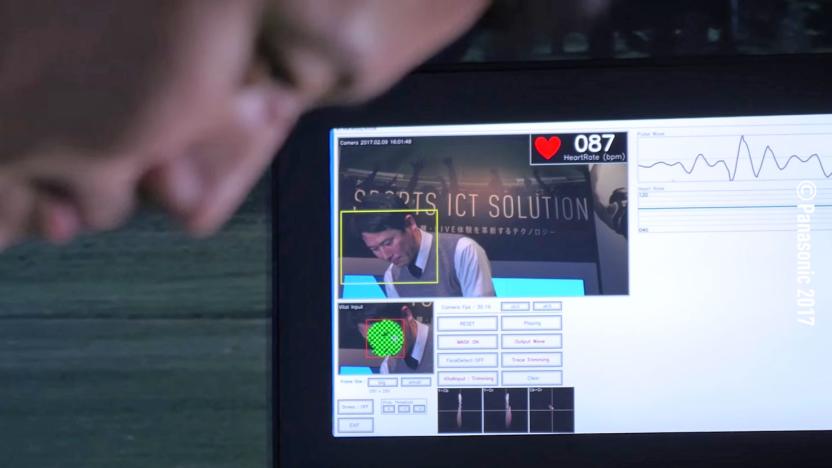KyotoUniversity
Latest

High-tech solutions top the list in the fight against eye disease
"The eyes are the window to the soul," the adage goes, but these days our eyes could be better compared to our ethernet connection to the world. According to a 2006 study conducted by the University of Pennsylvania, the human retina is capable of transmitting 10 million bits of information per second. But for as potent as our visual capabilities are, there's a whole lot that can go wrong with the human eye. Cataracts, glaucoma and age-related macular degeneration (AMD) are three of the leading causes of blindness the world over. Though we may not have robotic ocular prosthetics just yet, a number of recent ophthalmological advancements will help keep the blinds over those windows from being lowered.

Panasonic can read your heart rate by looking at your face
Being a sports professional means keeping calm in high-pressure situations, or at least pretending you are when actually freaking out. Spectators are typically none the wiser, but Panasonic will be giving viewers some additional insight into the mind of golfers competing at the Panasonic Open Golf Championship 2017, which tees off in Japan later this month. Coverage of the tournament, which is being broadcast on Japanese TV and online, will show the heart rate of golfers on-screen, so you can watch the nerves kick in as someone steps up to attempt a clutch, chip-in birdie. It's intended to add a bit more drama to the otherwise slow proceedings, but just as interesting is how Panasonic plans on making this happen, using what the company calls "contactless vital sensing" by way of a special camera.

Japanese researchers create palladium-like alloy using nanotechnology, 'present-day alchemy'
As you're no doubt aware, some of the precious metals used in consumer electronics -- like palladium -- can be both pricey and hard to come by, which has prompted some to harvest the materials from old electronics and reuse them, while others have been busily working on more readily available alternatives. Among that latter group are a team of researchers from Japan's Kyoto University, who have just announced that they've managed to create a palladium-like alloy using what's being described as "present-day alchemy." More specifically, they used nanotechnology to combine (and "nebulise") rhodium and silver, which don't ordinarily mix, into the new composite, which they say could eventually replace the real thing in a whole range of electronics and other products. Unfortunately, it's not clear when that might happen, but the researchers aren't just stopping at palladium -- they're apparently already looking at using a similar process to create other alloys. [Image credit: Jurii / Wikimedia Commons]

Digital Rosetta Stone memory could last a thousand years
The race for bigger and better memory continues apace, it seems. It was only a week or two ago that we caught wind of the work that scientists in Berkeley were doing with nanotubes and thousand-year-plus memory lifespans, and now it looks like a group of researchers in Japan have made some headway using an electron-beam direct-writing technique that utilizes semiconductor devices that can keep data intact for a thousand years, so long as humidity is kept at 2% or less. The prototype Digital Rosetta Stone, developed by Keio University, Kyoto University, and Sharp, has a storage capacity of 2.5TB and a max transmission speed of 150Mbps. Of course, there's no telling if or when this will become a reality, so if you want to ensure that your adolescent poetry lasts for the next thousand years, you'd better print out your MySpace blog and have it carved in granite.[Via TechShout]

Super-slim laser beams promise to boost optical disc capacity
Researchers at Japan's Kyoto University have recently announced a breakthrough method for shaping laser beams that could result in optical disc capacities up to ten times higher than what's current available from state-of-the-art HD DVD and Blu-ray discs. Using several layers of so-called photonic crystals incorporated into a small semiconductor chip, the researchers were able to manipulate a light beam's constituent photons in such a way that the resulting laser output could be shaped into a number of exotic beam patterns -- such as hollow beams, concentric hollow beams, and most importantly for optical disc capacity, solid beams with diameters much smaller than had been previously achievable. The best part about this technology is that the narrow beams can be formed without changing the wavelength of the laser, meaning that the technique could theoretically be applied to existing blue lasers, enabling next-gen optical discs to hold hundreds of gigabytes worth of data. Or, to put this in layman's terms, the $1,000 BD-P1000 you're planning on buying will now be, like, totally obsolete before you even tear open the box.


